Trimethylamine Sensors Based on Au-Modified Hierarchical Porous Single-Crystalline ZnO Nanosheets
Abstract
:1. Introduction
2. Experiment
2.1. Materials and Instrumentation
2.2. Preparation of the HPSCZNs
2.3. Synthesis of the Au Nanoparticles (NPs) and Au-Modified HPSCZNs
2.4. Gas-Sensing Measurement System and the Gas Sensor Fabrication
3. Results and Discussion
3.1. Characterization of the Au-Modified HPSCZNs
3.2. Formation Process of Au-Modified HPSCZNs
3.3. Operating Temperature of Au-Modified HPSCZNs
3.4. Gas-Sensing Property of Different Contents of Au NPs-Modified HPSCZNs
3.5. Comparison of Unmodified and Au-Modified HPSCZNs Sensors to TMA
3.6. Gas-Sensing Property of the Au-Modified HPSCZNs Sensor to TMA
3.7. Selectivity and Stability of the Au-Modified HPSCZNs Sensors
3.8. Sensing Mechanism of Au-Modified HPSCZNs
4. Conclusions
Acknowledgments
Author Contributions
Conflicts of Interest
References
- Garcia, M.R.; Cabo, M.L.; Herrera, J.R.; Ramilo-Fernandez, G.; Alonso, A.A.; Balsa-Canto, E. Smart sensor to predict retail fresh fish quality under ice storage. J. Food Eng. 2017, 197, 87–97. [Google Scholar] [CrossRef]
- Olafsdottir, G.; Nesvadba, P.; Di Natale, C.; Careche, M.; Oehlenschager, J.; Tryggvadottir, S.V.; Schubring, R.; Kroeger, M.; Heia, K.; Esaiassen, M.; et al. Multisensor for fish quality determination. Trends Food Sci. Tech. 2004, 15, 86–93. [Google Scholar] [CrossRef]
- Cheng, J.H.; Sun, D.W.; Zeng, X.A.; Liu, D. Recent Advances in Methods and Techniques for Freshness Quality Determination and Evaluation of Fish and Fish Fillets: A Review. Crit. Rev. Food Sci. 2015, 55, 1012–1025. [Google Scholar] [CrossRef] [PubMed]
- Chu, X.F.; Liang, S.M.; Sun, W.Q.; Zhang, W.B.; Chen, T.Y.; Zhang, Q.F. Trimethylamine sensing properties of sensors based on MoO3 microrods. Sens. Actuators B Chem. 2010, 148, 399–403. [Google Scholar] [CrossRef]
- Na, C.W.; Park, S.Y.; Lee, J.H. Punched ZnO nanobelt networks for highly sensitive gas sensors. Sens. Actuators B Chem. 2012, 174, 495–499. [Google Scholar] [CrossRef]
- Meng, F.L.; Li, H.H.; Kong, L.T.; Liu, J.Y.; Jin, Z.; Li, W.; Jia, Y.; Liu, J.H.; Huang, X.J. Parts per billion-level detection of benzene using SnO2/graphene nanocomposite composed of sub-6 nm SnO2 nanoparticles. Anal. Chim. Acta 2012, 736, 100–107. [Google Scholar] [CrossRef] [PubMed]
- Sun, Y.F.; Huang, X.J.; Meng, F.L.; Liu, J.H. Study of influencing factors of dynamic measurements based on SnO2 gas sensor. Sensors 2004, 4, 95–104. [Google Scholar] [CrossRef]
- Zhang, W.H.; Zhang, W.D. Fabrication of SnO2-ZnO nanocomposite sensor for selective sensing of trimethylamine and the freshness of fishes. Sens. Actuators B Chem. 2008, 134, 403–408. [Google Scholar] [CrossRef]
- Jung, J.Y.; Lee, C.S. Characteristics of the TiO2/SnO2 thick film semiconductor gas sensor to determine fish freshness. J. Ind. Eng. Chem. 2011, 17, 237–242. [Google Scholar] [CrossRef]
- Lee, C.S.; Kim, I.D.; Lee, J.H. Selective and sensitive detection of trimethylamine using ZnO-In2O3 composite nanofibers. Sens. Actuators B Chem. 2013, 181, 463–470. [Google Scholar] [CrossRef]
- Chu, X.F.; Liang, S.M.; Chen, T.Y.; Zhang, Q.F. Trimethylamine sensing properties of CdO-Fe2O3 nano-materials prepared using co-precipitation method in the presence of PEG400. Mater. Chem. Phys. 2010, 123, 396–400. [Google Scholar] [CrossRef]
- Lou, Z.; Li, F.; Deng, J.A.; Wang, L.L.; Zhang, T. Branch-like Hierarchical Heterostructure (alpha-Fe2O3/TiO2): A Novel Sensing Material for Trimethylamine Gas Sensor. Acs Appl. Mater. Interfaces 2013, 5, 12310–12316. [Google Scholar] [CrossRef] [PubMed]
- Jin, Z.; Zhang, Y.X.; Meng, F.L.; Jia, Y.; Luo, T.; Yu, X.Y.; Wang, J.; Liu, J.H.; Huang, X.J. Facile synthesis of porous single crystalline ZnO nanoplates and their application in photocatalytic reduction of Cr(VI) in the presence of phenol. J. Hazard. Mater. 2014, 276, 400–407. [Google Scholar] [CrossRef] [PubMed]
- Liu, J.Y.; Guo, Z.; Meng, F.L.; Luo, T.; Li, M.Q.; Liu, J.H. Novel porous single-crystalline ZnO nanosheets fabricated by annealing ZnS(en)0.5 (en = ethylenediamine) precursor. Application in a gas sensor for indoor air contaminant detection. Nanotechnology 2009, 20. [Google Scholar] [CrossRef] [PubMed]
- Song, H.Y.; Yang, H.; Ma, X.C. A comparative study of porous ZnO nanostructures synthesized from different zinc salts as gas sensor materials. J. Alloy. Compd. 2013, 578, 272–278. [Google Scholar] [CrossRef]
- Woo, H.S.; Na, C.; Kim, I.D.; Lee, J.H. Highly sensitive and selective trimethylamine sensor using one-dimensional ZnO-Cr2O3 hetero-nanostructures. Nanotechnology 2012, 23. [Google Scholar] [CrossRef] [PubMed]
- Sivalingam, D.; Gopalakrishnan, J.B.; Rayappan, J.B.B. Structural, morphological, electrical and vapour sensing properties of Mn doped nanostructured ZnO thin films. Sens. Actuators B Chem. 2012, 166, 624–631. [Google Scholar] [CrossRef]
- Joshi, R.K.; Hu, Q.; Am, F.; Joshi, N.; Kumar, A. Au Decorated Zinc Oxide Nanowires for CO Sensing. J. Phys. Chem C 2009, 113, 16199–16202. [Google Scholar] [CrossRef]
- Tamaekong, N.; Liewhiran, C.; Wisitsoraat, A.; Phanichphant, S. Sensing Characteristics of Flame-Spray-Made Pt/ZnO Thick Films as H2 Gas Sensor. Sensors 2009, 9, 6652–6669. [Google Scholar] [CrossRef] [PubMed]
- Simon, Q.; Barreca, D.; Gasparotto, A.; Maccato, C.; Tondello, E.; Sada, C.; Comini, E.; Devi, A.; Fischer, R.A. Ag/ZnO nanomaterials as high performance sensors for flammable and toxic gases. Nanotechnology 2012, 23. [Google Scholar] [CrossRef] [PubMed]
- Zhu, G.X.; Liu, Y.J.; Xu, H.; Chen, Y.; Shen, X.P.; Xu, Z. Photochemical deposition of Ag nanocrystals on hierarchical ZnO microspheres and their enhanced gas-sensing properties. Crystengcomm 2012, 14, 719–725. [Google Scholar] [CrossRef]
- Meng, F.L.; Guo, Z.; Huang, X.J. Graphene-based hybrids for chemiresistive gas sensors. TrAC Trends Anal. Chem. 2015, 68, 37–47. [Google Scholar] [CrossRef]
- Kim, S.S.; Park, J.Y.; Choi, S.W.; Kim, H.S.; Na, H.G.; Yang, J.C.; Kim, H.W. Significant enhancement of the sensing characteristics of In2O3 nanowires by functionalization with Pt nanoparticles. Nanotechnology 2010, 21. [Google Scholar] [CrossRef] [PubMed]
- Meng, F.L.; Hou, N.N.; Jin, Z.; Sun, B.; Guo, Z.; Kong, L.T.; Xiao, X.H.; Wu, H.; Li, M.Q.; Liu, J.H. Ag-decorated ultra-thin porous single-crystalline ZnO nanosheets prepared by sunlight induced solvent reduction and their highly sensitive detection of ethanol. Sens. Actuators B Chem. 2015, 209, 975–982. [Google Scholar] [CrossRef]
- Meng, F.L.; Hou, N.N.; Jin, Z.; Sun, B.; Li, W.Q.; Xiao, X.H.; Wang, C.; Li, M.Q.; Liu, J.H. Sub-ppb detection of acetone using Au-modified flower-like hierarchical ZnO structures. Sens. Actuators B Chem. 2015, 219, 209–217. [Google Scholar] [CrossRef]
- Gu, C.P.; Huang, H.H.; Huang, J.R.; Jin, Z.; Zheng, H.X.; Liu, N.; Li, M.Q.; Liu, J.H.; Meng, F.L. Chlorobenzene sensor based on Pt-decorated porous single-crystalline ZnO nanosheets. Sens. Actuators A Phys. 2016, 252, 96–103. [Google Scholar] [CrossRef]
- Meng, F.L.; Ge, S.; Jia, Y.; Sun, B.; Sun, Y.F.; Wang, C.; Wu, H.; Jin, Z.; Li, M.Q. Interlaced nanoflake-assembled flower-like hierarchical ZnO microspheres prepared by bisolvents and their sensing properties to ethanol. J. Alloy Compd. 2015, 632, 645–650. [Google Scholar] [CrossRef]
- Meng, F.L.; Hou, N.N.; Ge, S.; Sun, B.; Jin, Z.; Shen, W.; Kong, L.T.; Guo, Z.; Sun, Y.F.; Wu, H.; et al. Flower-like hierarchical structures consisting of porous single-crystalline ZnO nanosheets and their gas sensing properties to volatile organic compounds (VOCs). J. Alloy Compd. 2015, 626, 124–130. [Google Scholar] [CrossRef]
- Hou, N.N.; Jin, Z.; Sun, B.; Sun, Y.F.; Shen, W.; Guo, Z.; Kong, L.T.; Li, M.Q.; Meng, F.L. New Strategy for Rapid Detection of the Simulants of Persistent Organic Pollutants Using Gas Sensor Based on 3-D Porous Single-Crystalline ZnO Nanosheets. IEEE Sens. J. 2015, 15, 3668–3674. [Google Scholar] [CrossRef]
- Frens, G. Controlled Nucleation for the Regulation of the Particle Size in Monodisperse Gold Suspensions. Nat. Phys. Sci. 1973, 241, 20–22. [Google Scholar] [CrossRef]
- Pavluchenko, A.S.; Mamykin, A.V.; Kukla, A.L.; Konoshchuk, N.V.; Posudievsky, O.Y.; Koshechko, V.G. Estimation of multicomponent organic solvent vapor mixture composition with electroconducting polymer chemiresistors. Sens. Actuators B Chem. 2016, 232, 203–218. [Google Scholar] [CrossRef]
- Wang, Q.J.; Liu, F.M.; Lin, J.; Lu, G.Y. Gas-sensing properties of In-Sn oxides composites synthesized by hydrothermal method. Sens. Actuators B Chem. 2016, 234, 130–136. [Google Scholar] [CrossRef]
- Kwon, T.H.; Park, S.H.; Ryu, J.Y.; Choi, H.H. Zinc oxide thin film doped with Al2O3, TiO2 and V2O5 as sensitive sensor for trimethylamine gas. Sens. Actuators B Chem. 1998, 46, 75–79. [Google Scholar]
- Chang, J.; Ahmad, M.Z.; Wlodarski, W.; Waclawik, E.R. Self-Assembled 3D ZnO Porous Structures with Exposed Reactive {0001} Facets and Their Enhanced Gas Sensitivity. Sensors 2013, 13, 8445–8460. [Google Scholar] [CrossRef] [PubMed]
- Barsan, N.; Weimar, U. Conduction model of metal oxide gas sensors. J. Electroceram. 2001, 7, 143–167. [Google Scholar] [CrossRef]
- Guo, J.; Zhang, J.; Zhu, M.; Ju, D.X.; Xu, H.Y.; Cao, B.Q. High-performance gas sensor based on ZnO nanowires functionalized by Au nanoparticles. Sens. Actuators B Chem. 2014, 199, 339–345. [Google Scholar] [CrossRef]
- Luo, X.J.; Lou, Z.; Wang, L.L.; Zheng, X.J.; Zhang, T. Fabrication of flower-like ZnO nanosheet and nanorod-assembled hierarchical structures and their enhanced performance in gas sensors. New J. Chem. 2014, 38, 84–89. [Google Scholar] [CrossRef]
- Liu, Z.T.; Fan, T.X.; Zhang, D.; Gong, X.L.; Xu, J.Q. Hierarchically porous ZnO with high sensitivity and selectivity to H(2)S derived from biotemplates. Sens. Actuators B Chem. 2009, 136, 499–509. [Google Scholar] [CrossRef]
- Li, H.H.; Meng, F.L.; Liu, J.Y.; Sun, Y.F.; Jin, Z.; Kong, L.T.; Hu, Y.J.; Liu, J.H. Synthesis and gas sensing properties of hierarchical meso-macroporous SnO2 for detection of indoor air pollutants. Sens. Actuators B Chem. 2012, 166, 519–525. [Google Scholar] [CrossRef]
- Matsunaga, N.; Sakai, G.; Shimanoe, K.; Yamazoe, N. Formulation of gas diffusion dynamics for thin film semiconductor gas sensor based on simple reaction-diffusion equation. Sens. Actuators B Chem. 2003, 96, 226–233. [Google Scholar] [CrossRef]
- Sakai, G.; Matsunaga, N.; Shimanoe, K.; Yamazoe, N. Theory of gas-diffusion controlled sensitivity for thin film semiconductor gas sensor. Sens. Actuators B Chem. 2001, 80, 125–131. [Google Scholar] [CrossRef]
- Yang, J.H.; Cermakova, J.; Uchytil, P.; Hamel, C.; Seidel-Morgenstern, A. Gas phase transport, adsorption and surface diffusion in a porous glass membrane. Catal. Today 2005, 104, 344–351. [Google Scholar] [CrossRef]
- Korotcenkov, G. The role of morphology and crystallographic structure of metal oxides in response of conductometric-type gas sensors. Mat. Sci. Eng. R 2008, 61, 1–39. [Google Scholar] [CrossRef]
- Liu, C.; Kuang, Q.; Xie, Z.X.; Zheng, L.S. The effect of noble metal (Au, Pd and Pt) nanoparticles on the gas sensing performance of SnO2-based sensors: A case study on the {221} high-index faceted SnO2 octahedra. CrystEngComm 2015, 17, 6308–6313. [Google Scholar] [CrossRef]
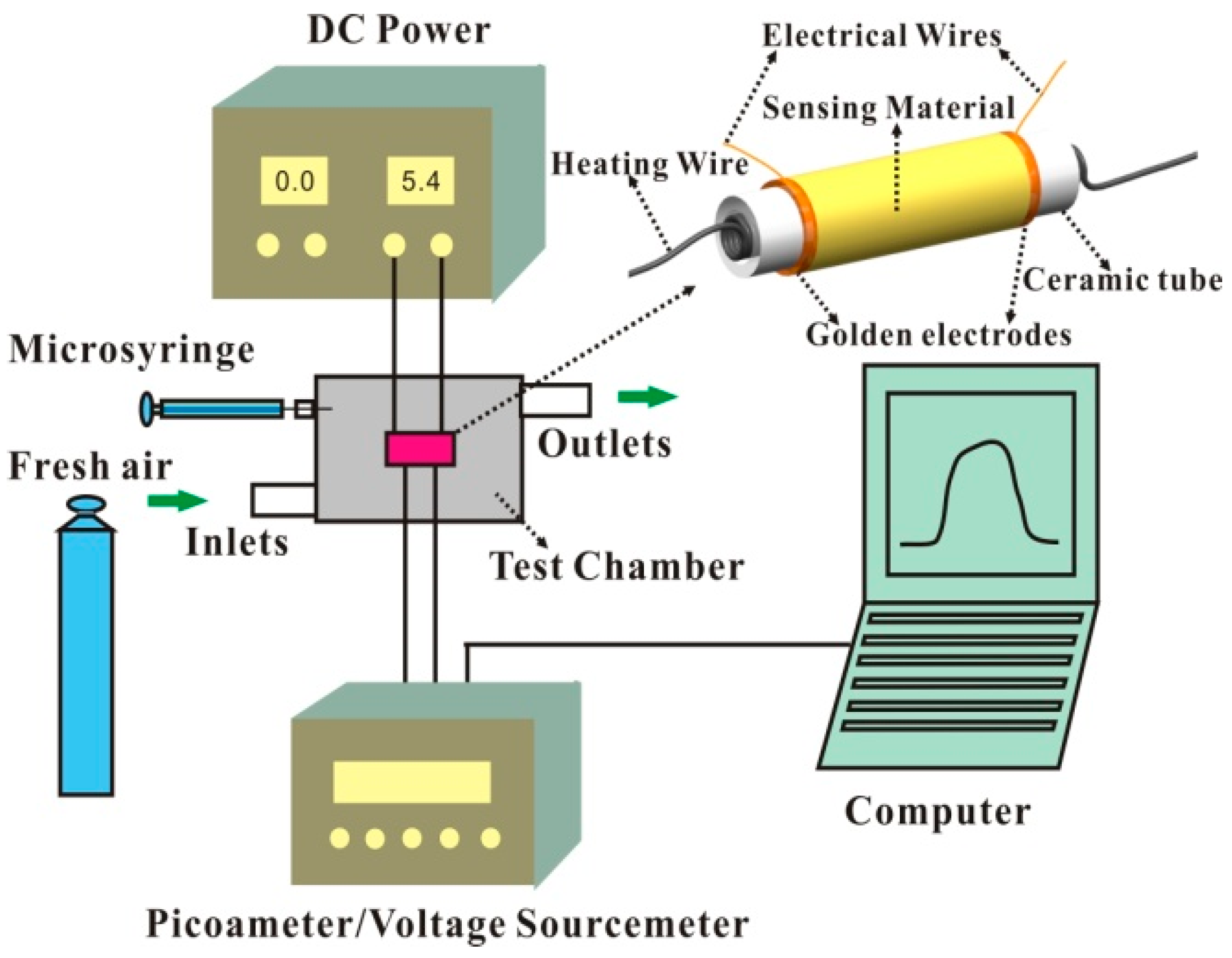
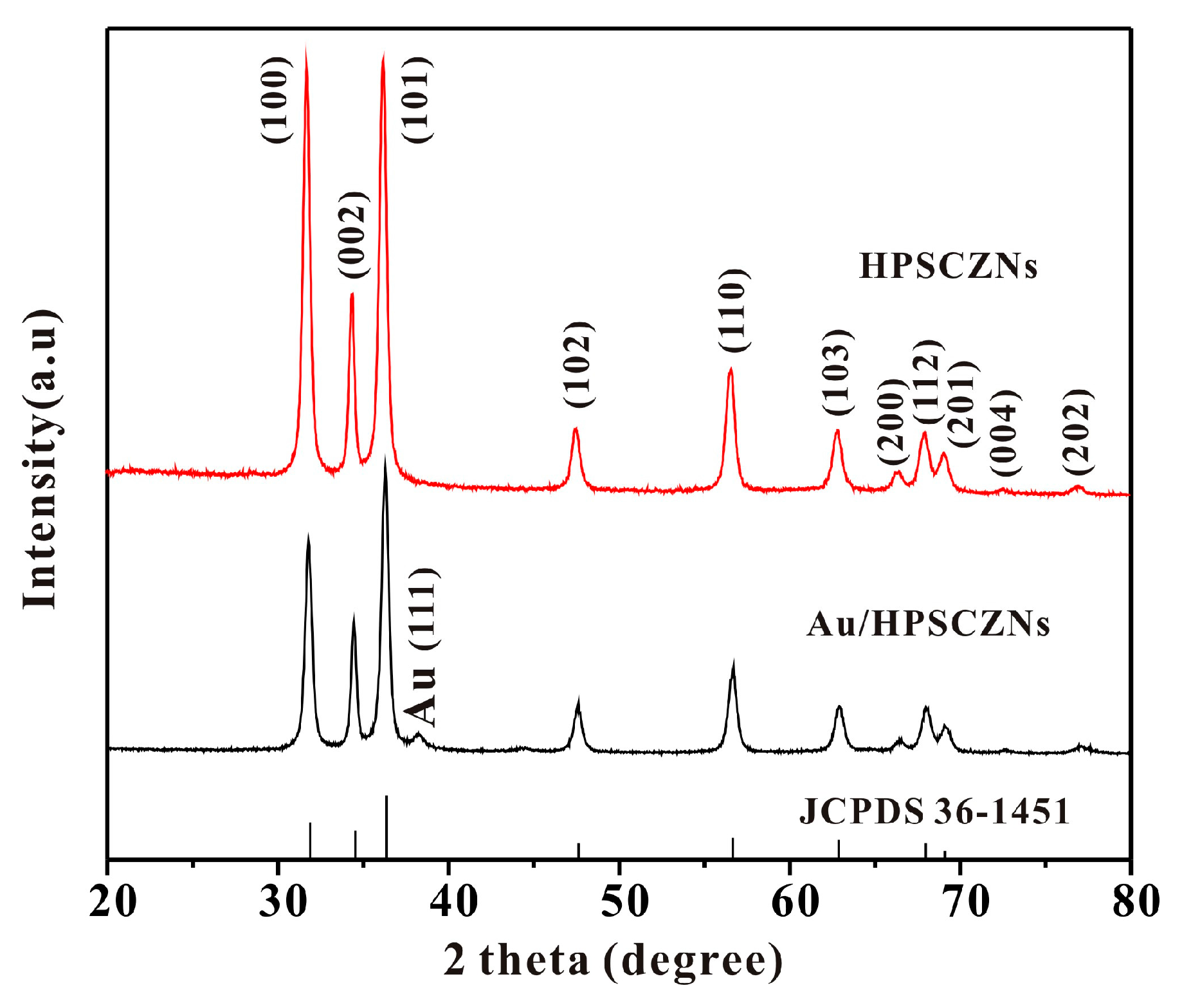


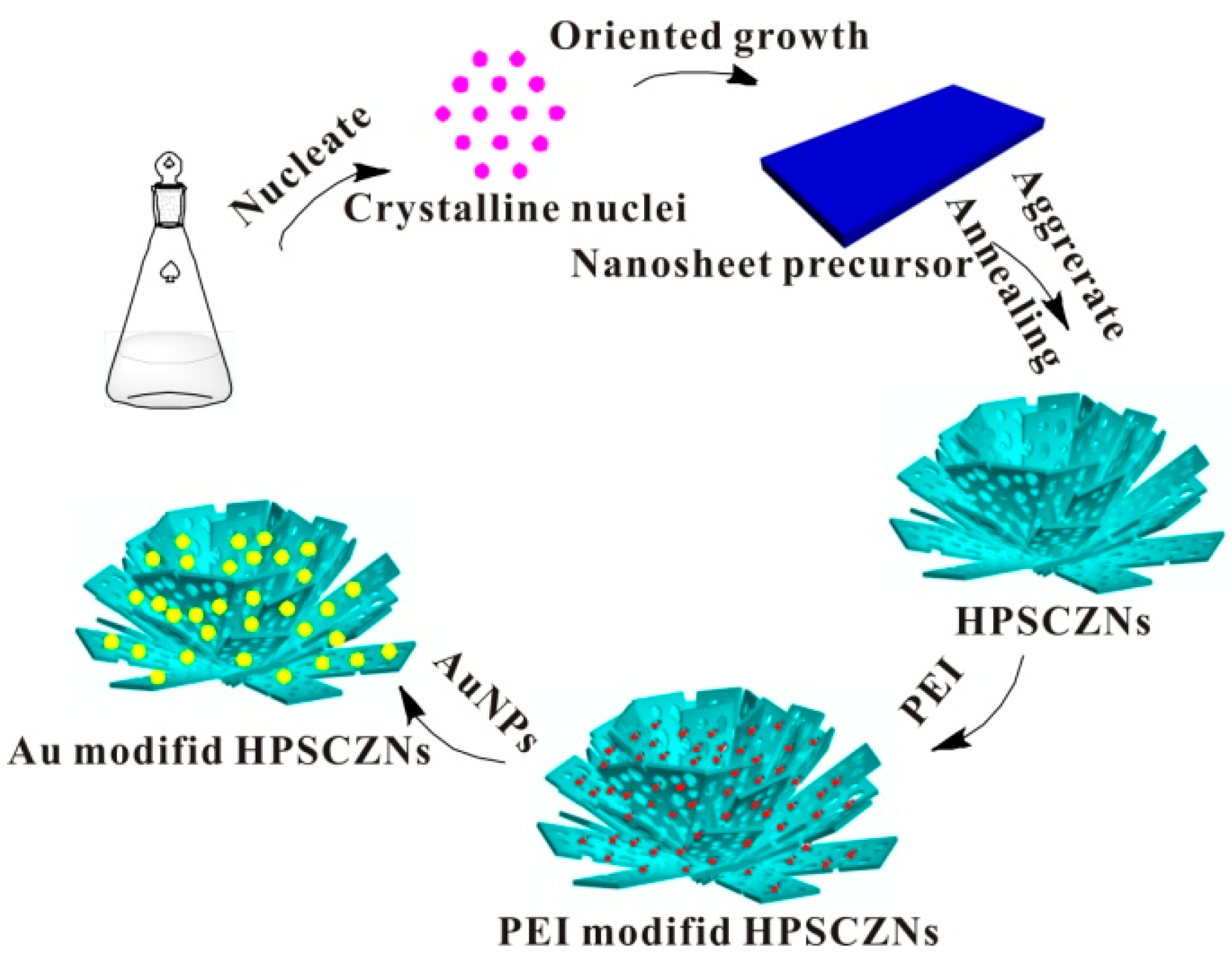
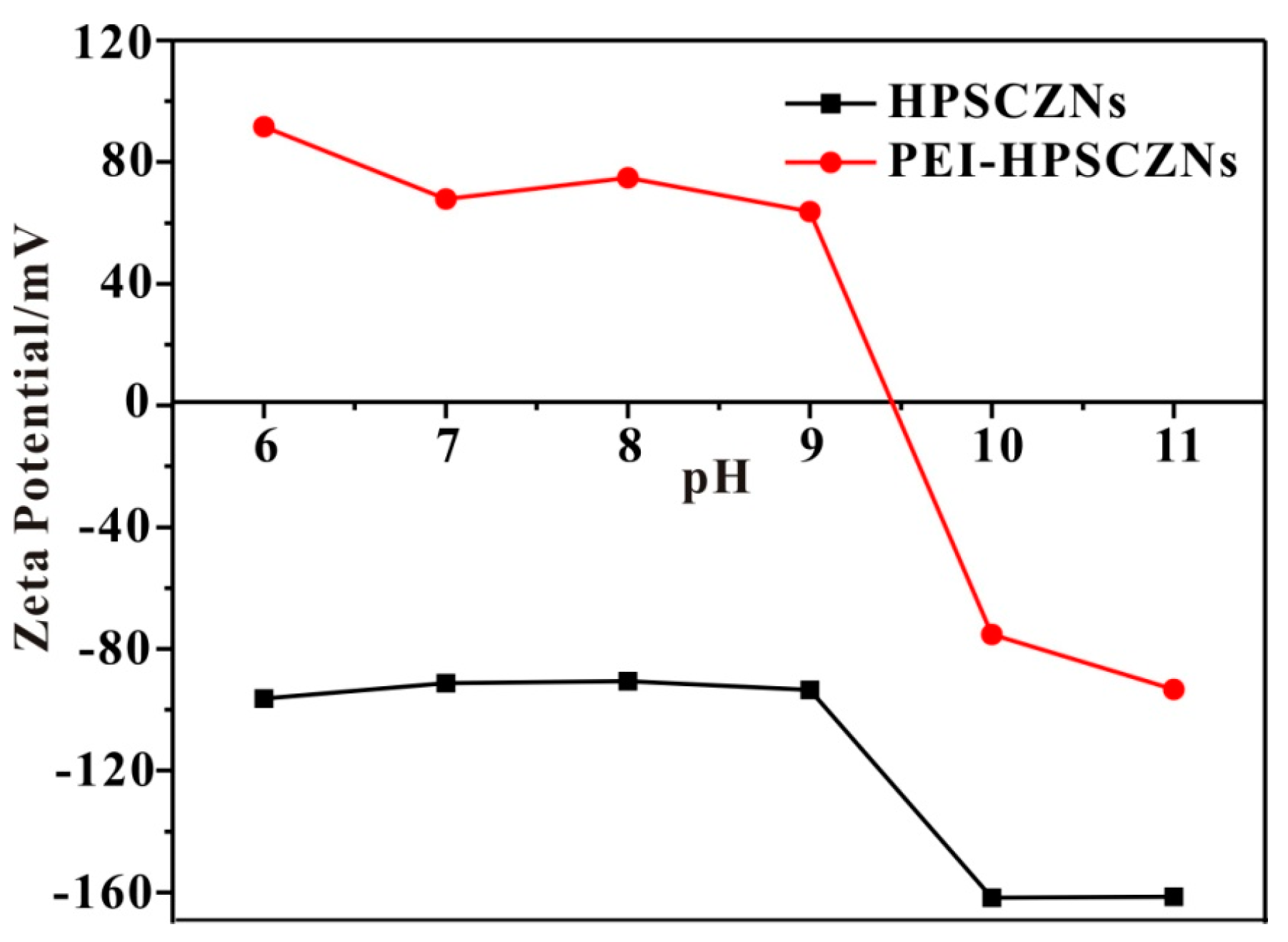
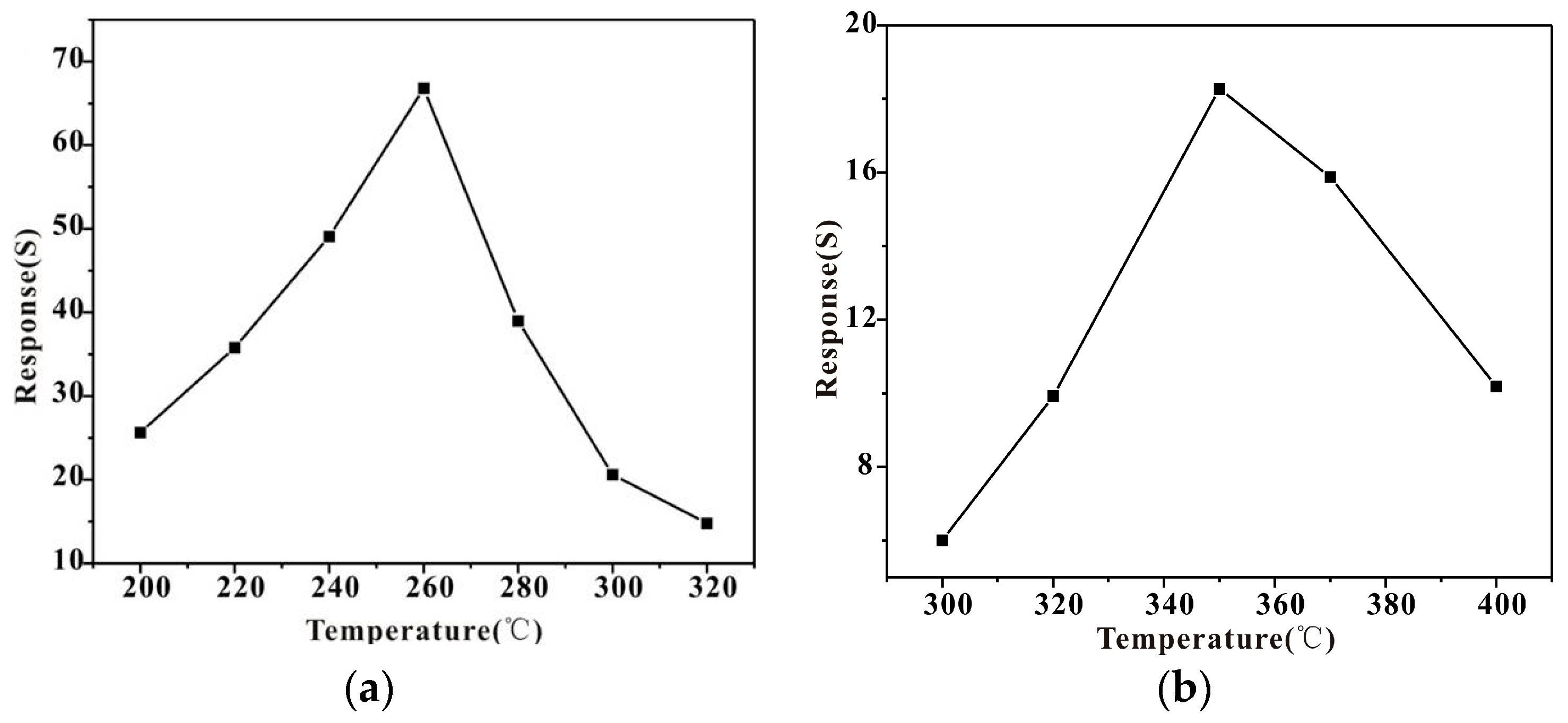
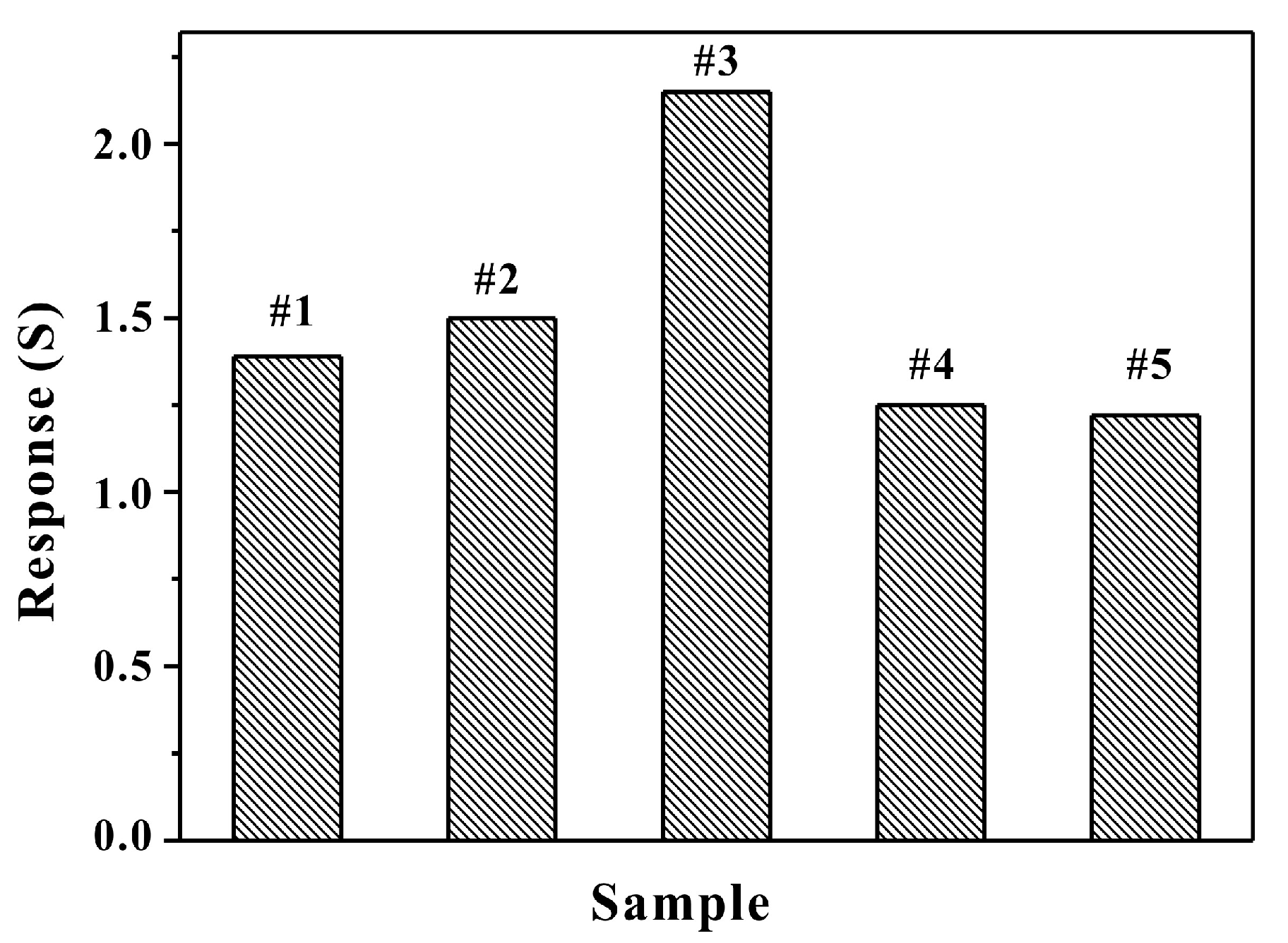

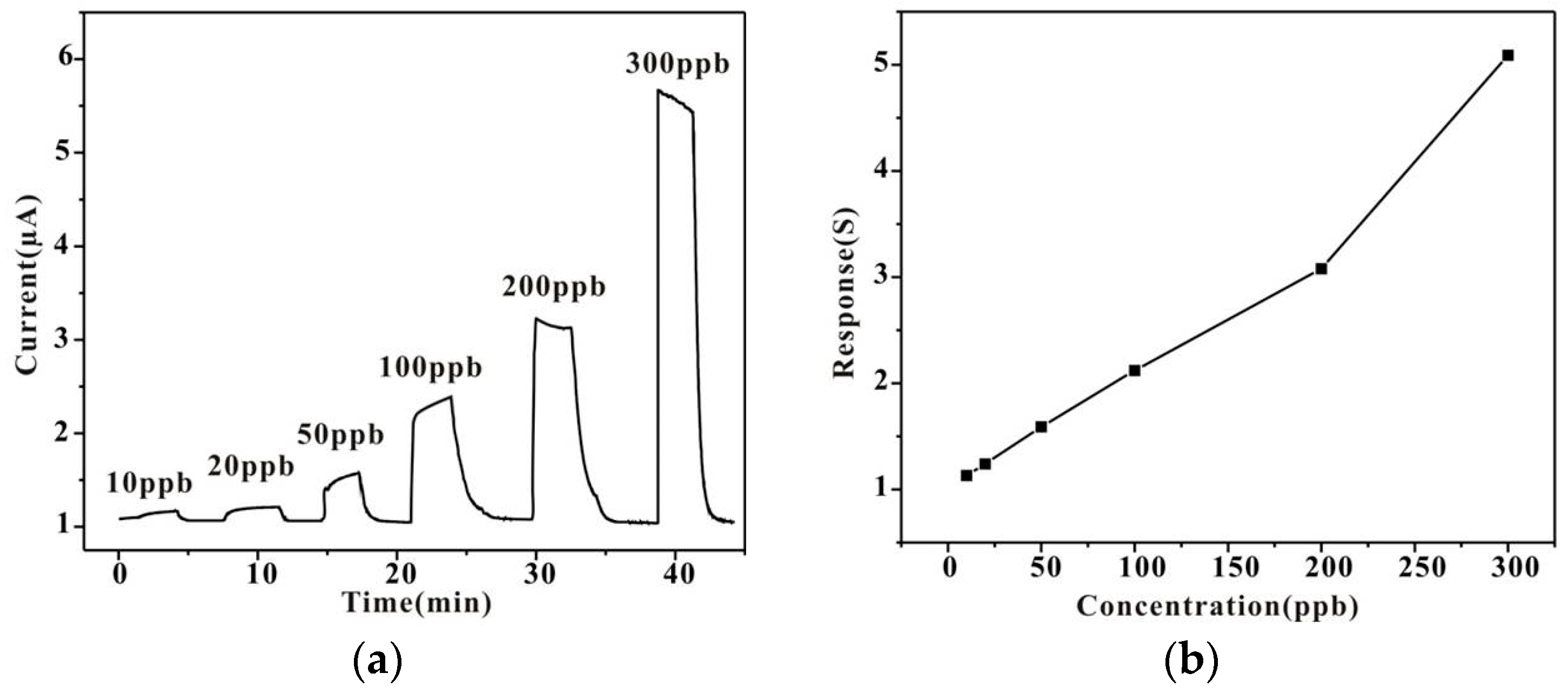
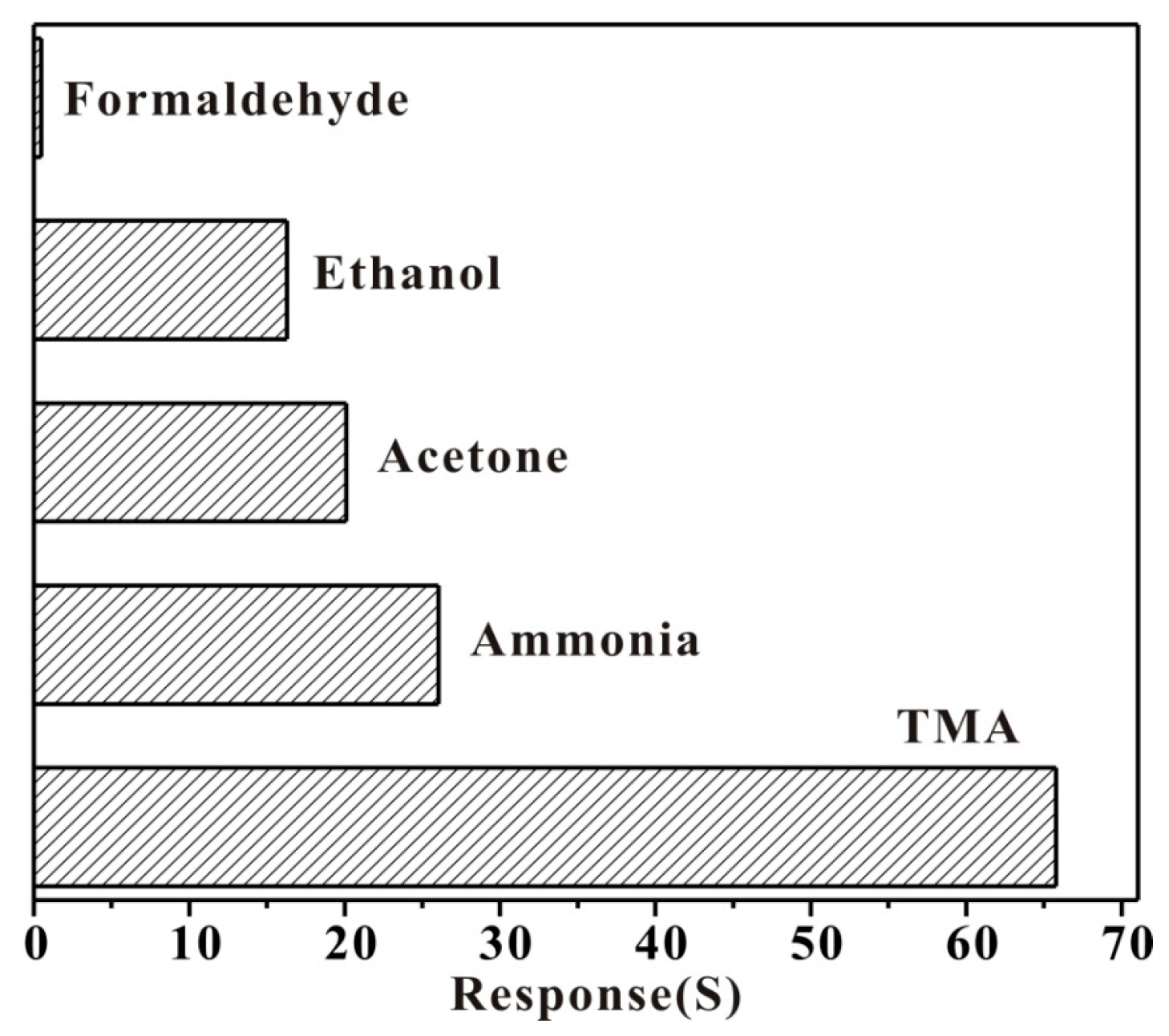
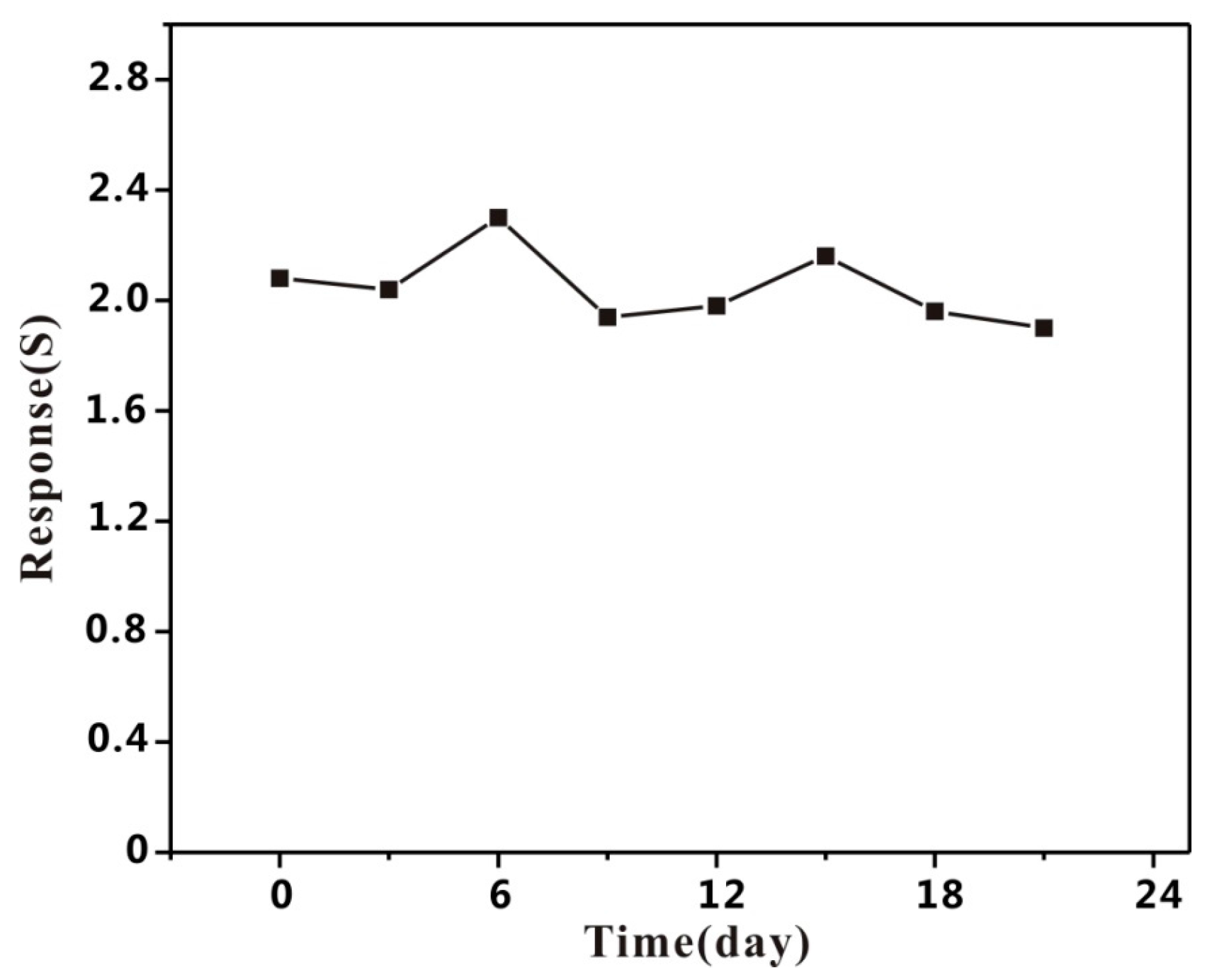
| Gas Type | Molecular Structures | Bond | Bond Energy (KJ/mol) |
|---|---|---|---|
| Formaldehyde |  | H–CHO | 436 |
| Ethanol |  | H–OCH2CH3 | 436 |
| H–CH2 | 473 | ||
| H–CH | 452 | ||
| Acetone |  | H–CH2OCH3 | 393 |
| Ammonia |  | H–NH2 | 435 |
| TMA |  | H–CH2 | 380.7 |
© 2017 by the authors. Licensee MDPI, Basel, Switzerland. This article is an open access article distributed under the terms and conditions of the Creative Commons Attribution (CC BY) license (http://creativecommons.org/licenses/by/4.0/).
Share and Cite
Meng, F.; Zheng, H.; Sun, Y.; Li, M.; Liu, J. Trimethylamine Sensors Based on Au-Modified Hierarchical Porous Single-Crystalline ZnO Nanosheets. Sensors 2017, 17, 1478. https://doi.org/10.3390/s17071478
Meng F, Zheng H, Sun Y, Li M, Liu J. Trimethylamine Sensors Based on Au-Modified Hierarchical Porous Single-Crystalline ZnO Nanosheets. Sensors. 2017; 17(7):1478. https://doi.org/10.3390/s17071478
Chicago/Turabian StyleMeng, Fanli, Hanxiong Zheng, Yufeng Sun, Minqiang Li, and Jinhuai Liu. 2017. "Trimethylamine Sensors Based on Au-Modified Hierarchical Porous Single-Crystalline ZnO Nanosheets" Sensors 17, no. 7: 1478. https://doi.org/10.3390/s17071478





